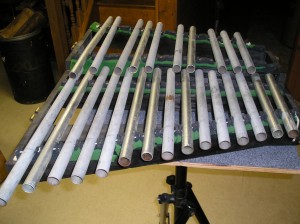As mentioned in several previous blog postings, I frequently receive emailed questions on various percussion-related subjects.
Question: After seeing the tubophone photo in your blog posting titled, “Instruments You Can’t Buy (Part 1 – Orchestra Repertoire)“ I’m considering the possibility of constructing one. Can you offer any suggestions?
Response: For the tubophone described in the blog, galvanized 3/4-inch (I.D.) electrical tubing was used, and the tubes are resting on a strip of indoor/outdoor carpeting supported on a homemade wooden frame.
Almost any kind of metal tubing will work, and the lengths of the tubes will vary, depending on the particular metal tubing thickness. The longest tube (C2 – one octave above middle-C) on the instrument in the photo is about 21-inches long.
You will need access to a hacksaw (or a metal-cutting blade on an electric saw) to cut the tubing, and a tuning fork or other device to determine pitch, If you build the frame you’ll need access to a table saw to cut the wood, a drill press or handheld drill and bits to drill screw holes, a boxcutter to cut the carpeting, and a screwdriver and metal file.
My suggestion is to start with the longest tube. Using whatever metal tubing you select, cut a piece about 22-inches long. Holding the cut piece between your thumb and first-finger, about 4-inches (plus or minus) from either end of the tube, tap the tube to determine its approximate pitch by ear. Next, the tube will have to be cut in small increments (1/32nd or less to about 1/8-inch) until it is at exactly the closest true pitch (it could be C2, or if the tube is too short it could be C#2, in which case you would next cut a longer piece of tubing – maybe 23 or 24-inches in length).
Assuming that the tube has eventually been cut to exactly the desired C2, the next step would be to cut a second tube at the same length and then repeat the process of cutting in small increments until you arrive at C#2. Then cut a third tube at the same length as the C#2 and continue the process on and on through all remaining notes until you have your two-octaves. Obviously, there will be a lot of cutting, and if you do this by hand it could easily take all day (or more) just to cut the tubes.
For the frame, you can use 1”X 4” knotty pine boards (available at Lowe’s, Home Depot etc.). Lay out the tubes first to determine the lengths of the frame pieces. Find and mark the two nodal points – at 1/5th of the tube’s length from both ends – on the longest and shortest tubes. The frame should go directly below these points, with the remaining tubes sitting on the frame as they lay.
It might be helpful for you to look at a marimba or xylophone frame to get some idea of how the frame relates to the bars. These are some of the main issues, and you will certainly have to expect some trial and error as you go along.

